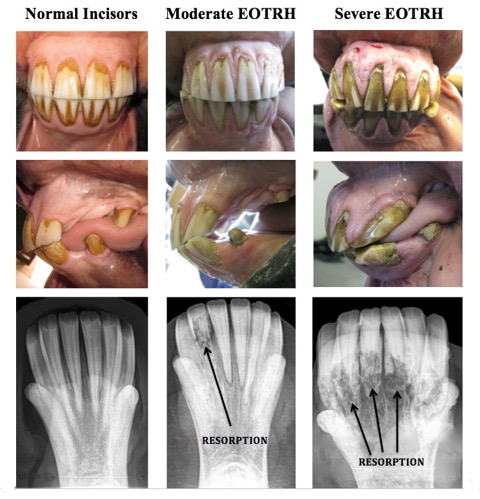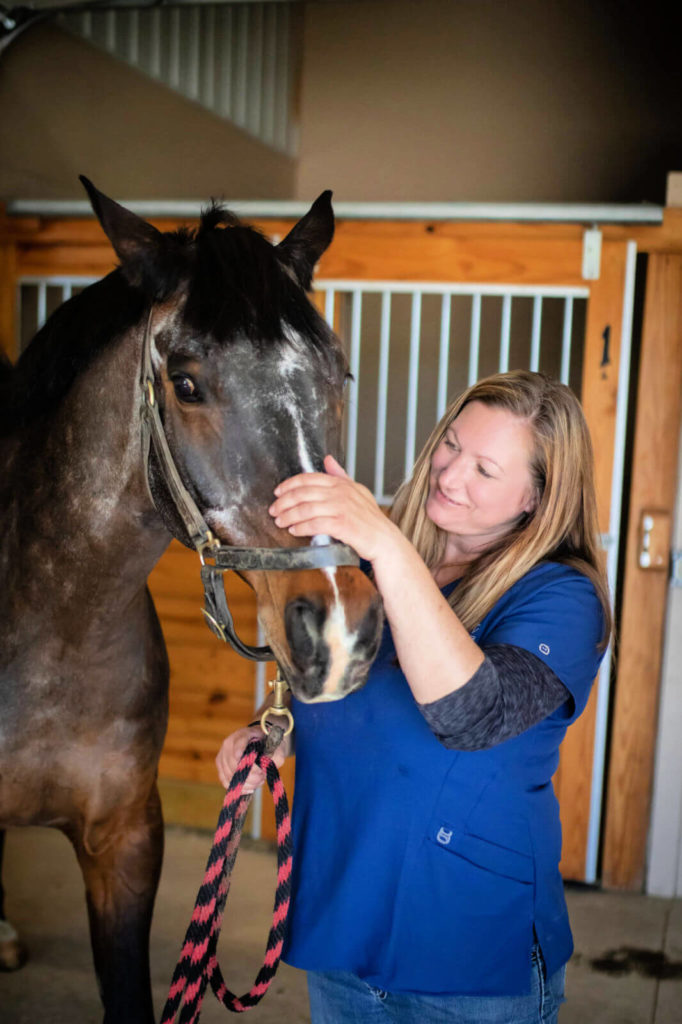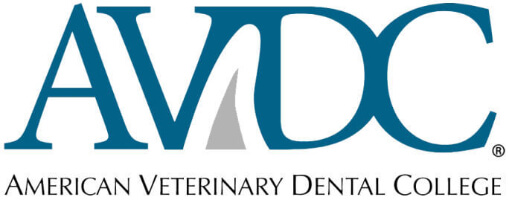
What is EOTRH Syndrome?
Equine Odontoclastic Tooth Resorption and Hypercementosis, also known as EOTRH, is a syndrome in horses that results in resorptive lesions of the incisors and sometimes canine teeth.
It is usually gradual in onset, though often isn’t diagnosed until quite extensive lesions are present. Most commonly it is a condition of older horses (15+), though we have seen it in horses as young as 13.
While this syndrome has probably existed for many years, it has only recently been properly identified and named. Diagnosis is typically made through radiographs of the incisors. This is the only way to know definitively how many teeth are affected, and how severe the lesions are.
We currently do not know the underlying cause for the syndrome. Because of this, there is no known treatment at this time to help prevent this from happening. The treatment for affected teeth is extraction based on staging of lesions present radiographically.
EOTRH Brochure

At Midwest Veterinary Dental Services, we are passionate about providing the highest quality and most current dental care for our
patients.
We provide this information to educate our clients so that they know the warning signs and potential effects of EOTRH on their horses.
Please download our free EOTRH brochure and share it with other horse owners.
Why is this important?
As the disease progresses, the roots of the incisors (and sometimes canines) start to resorb, or basically dissolve. This is an inflammatory process. Some horses also develop hypercementosis, which is an excessive buildup of cementum (calcified tissue) on the roots of one or more teeth. This process can give the appearance of bulb-like swellings around the roots of the affected teeth.
Unfortunately, as the disease progresses affected teeth eventually start to loosen and become painful. As further resorption occurs, some horses may even fracture off weakened teeth. Many of these teeth become infected as well, as the roots continue to degrade. This can sometimes present with small red “dots” visible above the gum line of the incisors, or even small pimple-like draining tracts in this same area.
Many older horses are fairly stoic, and don’t always exhibit obvious outward signs of oral pain until the clinical disease is quite progressed. As severe changes occur, these horses can start to lose weight. Some horses will start to refuse biting down on treats or carrots, and some will quit grazing due to pain in their incisors.
As the disease becomes advanced, some horses may exhibit irritable behaviors when being bridled or ridden. Our goal is to avoid this from happening. In our experience, horses that are diagnosed and treated earlier on will have more positive outcomes (avoid pain and loss of weight).
It is also interesting to note that many horses bounce back tenfold after extraction of these teeth, even those that end up having all of their incisors extracted at once. Where their owner didn’t realize there was a painful component to their disease, the horses become much more bright, happy, and personable after the extractions.
Follow-up care
The follow-up care for horses that have had incisors extracted typically includes antibiotics and a soft diet for several weeks. Most horses are back to happily eating by the next day.
We usually recommend no riding with a bit for 2-4 weeks following the procedure. After that, they can resume all former activities.
If you have questions regarding your horse, please don’t hesitate to contact our office.
Frequently Asked Questions about EOTRH
Click on any question to reveal its answer:
Why are radiographs important?
Radiographs are essential to making a diagnosis, because most of this process occurs below the gum line and cannot be seen without proper radiographic evaluation.
What is the proper treatment of affected teeth?
We have extracted incisors on hundreds of horses for this condition over the past several years. The number of teeth that should be extracted is entirely related to the stage of disease when the diagnosis is made. If we can identify the disease process early on, there may only be 1-4 teeth affected.
As the disease becomes more progressive, all of the upper and/or lower incisors and canines may be affected. If all of these teeth are severely affected, there is no good clinical reason to leave any of them in place. We currently recommend that all horses over the age of 15 have their incisors radiographed to screen for this condition.
What should I expect after my horse has had teeth extracted because of EORTH?
The follow up care for horses that have had incisors extracted typically includes antibiotics and a soft diet for several weeks. Most horses are back to happily eating by the next day. We usually recommend no riding with a bit for 2-4 weeks following the procedure. After that, they can resume all former activities.
One common question that we get asked is whether or not the horse will be able to graze again after the extractions. The answer is absolutely yes! It doesn’t take very long for them to figure out how to rip the grasses off with their lips. The incisors are actually not used for chewing or grinding the food, this is done by the cheek teeth.
Will my horse be able to graze again after the extractions?
Yes, absolutely! It doesn’t take very long for them to figure out how to rip the grasses off with their lips. The incisors are actually not used for chewing or grinding the food, this is done by the cheek teeth.
Request an equine appointment
If you would like to make an appointment with Midwest Veterinary Dental Services, please visit the request page and fill out the form so we may have your information for scheduling purposes. We usually book out 4-6 weeks for appointments.
Routine Dentistry
Restoration & Endodontics
Oral Surgery
Periodontics
Young Horse Dentistry


